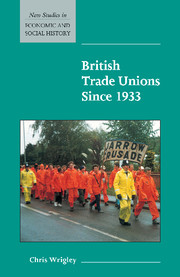Book contents
- Frontmatter
- Contents
- List of tables
- 1 Introduction
- 2 Economic recovery and war, 1933–1945
- 3 Trade union development, 1945–2000
- 4 Strikes, 1945–2000
- 5 Incomes policies, 1948–1979
- 6 Trade union legislation, 1945–2000
- 7 What have trade unions done?
- List of references
- Index
- Studies in Economic and Social History
- New Studies in Economic and Social History
7 - What have trade unions done?
Published online by Cambridge University Press: 05 June 2012
- Frontmatter
- Contents
- List of tables
- 1 Introduction
- 2 Economic recovery and war, 1933–1945
- 3 Trade union development, 1945–2000
- 4 Strikes, 1945–2000
- 5 Incomes policies, 1948–1979
- 6 Trade union legislation, 1945–2000
- 7 What have trade unions done?
- List of references
- Index
- Studies in Economic and Social History
- New Studies in Economic and Social History
Summary
The role of trade unions in Western industrialised societies became a highly controversial issue in the last two decades of the twentieth century. In an age of widespread renewed belief in the efficacy of free market economies, many economists and politicians saw them as blocks on the working of the free market. In contrast, many people who desired protection in ‘the flexible labour market’ saw more their ‘sword of justice’ role. In 1984, after examining trade union activities in the USA, Freeman and Medoff, two Harvard economists, observed that unions had two faces, ‘a monopoly face’ and ‘a voice/response face’, and concluded:
If one looks only at the monopoly face, most of what trade unions do is socially harmful. If one looks at only the voice/response face, most of what unions do is socially beneficial.
(Freeman and Medoff, 1984, 246)Freeman and Medoff in their study, What Do Trade Unions Do? focused on three areas of controversy: efficiency, distribution of income and social organisation. In their study of US trade unions they argued that trade unionism could lower employment levels but that ‘in many settings it is associated with increased productivity’. On the issue of distribution of income they found that unions reduced inequality in wages and lowered profits. As for social organisation they did not substantiate the belief that unions were corrupt or undemocratic and found that politically ‘unions, for the most part, provide political voice to all labor and that they are more effective in pushing general social legislation than in bringing about special interest legislation in the Congress’.
- Type
- Chapter
- Information
- British Trade Unions since 1933 , pp. 81 - 86Publisher: Cambridge University PressPrint publication year: 2002



